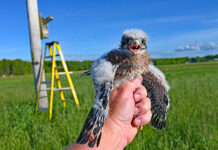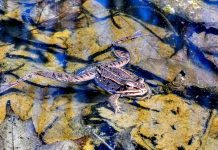The beginning of June is a special time for my family. For over 20 years, distant family members make their way to North Carolina’s barrier islands. Like birds of the same feather, we migrate back to the North Carolina coastline. Together, we make memories of boating, fishing and playing in the waves.
Most recently, we have been staying far south on Route 12 in the small town of Frisco, North Carolina. We like that the roar of the crashing ocean waves is louder than tourist attractions.
Even though we embrace tradition and look forward to the same yearly expeditions, this year turned out to be a little different. From wildlife to weather, our week unrolled in unexpected ways.
Our kids really enjoy taking the ferry operated by the state of North Carolina from Hatteras to Ocracoke Island. Instead of waiting until the midway point of the trip when traffic lines are long, we went early on Monday.
Secluded oasis
This turned out to be excellent planning to escape any crowds. The village of Ocracoke is only 4 square miles in area, but the undeveloped beaches stretch out for about 15 miles. Known for their seclusion and natural beauty, playing on the beach at Ocracoke made it seem like we were on our own private island.
Looking in either direction down the coast, we couldn’t see another person. However, many birds make their home on pristine beaches. To protect several species, a section of the beach was closed to vehicles, dogs, and people. Black skimmers, terns, and piping plovers need protection due to a decrease in number.
Black skimmers were once killed for their feathers. As their name implies, they skim the water with their lower mandible, snapping their upper mandible shut when they catch a fish. They fish by touch instead of by sight.
Many coastal birds like black skimmers and piping plovers lay their eggs right on the sand or shell fragments near small amounts of vegetation. The biggest threat to their survival is the loss of beach-nesting habitats. Ocracoke Island is included in the Cape Hatteras National Seashore; the protected beaches will remain in their exquisite natural state, undeveloped for years to come.
Back to civilization
After a morning of playing in the waves and collecting shells, we traveled farther south. The road is bordered on both sides by dunes covered in sea oats. Maritime forests and marshlands separate the road from the Pamlico Sound.
The quaint village of Ocracoke has a vibe all its own. Historical markers along with shops and restaurants make up the main stretch through town. Sailboats bob up and down on Silver Lake, which is more like a bay or lagoon. Other boats and a south-bound ferry also use the harbor. Pelicans perch on the pylons near the docks waiting patiently for their next snack.
After a quick stop for our own snack of ice cream, we headed back to Hatteras Island. The crowd of seagulls trailing the ferry grew as we made the 60-minute commute in the dredged channel.
Back at the beach house, another coastal bird made an appearance. I thought at first that it was a Northern cardinal. However, this bird had a leaner appearance and didn’t have the same crest. After some research, I realized it was a male Summer Tanager.
Crimson in color with a few orange feathers if it’s molting, summer tanagers are commonly seen in eastern North Carolina. These songbirds mainly eat insects and have a fondness for consuming bees.
Night birds
An evening trip to Cape Hatteras lighthouse made it possible to see the sunset behind the iconic black and white swirled beacon. We were in for another treat when a rare songbird could be heard trilling in the nearby trees.
Nocturnal by nature, a chuck-will’s-widow sounded like it was in the trees next to marshy inland water. Its repetitive call was so unique that it captured our undivided attention. It preys on moths, beetles, and other insects as it flies. This feeding habit is made possible by stiff feathers called rictal bristles that act as a funnel. The specialized feathers direct the bugs which serve as pops of protein into the bird’s wide-opening mouth.
A few big storms during the week scattered the birds and sent us scrambling for cover in the house. High winds cut the fishing success rate for the week in half, but the fishermen in our group did manage to catch one elusive pompano.
For our last morning on the island, I woke up early for the sunrise. With the moon still glittering on the waves, I walked north to see the first rays of daybreak over the dunes.
Without too many feathers ruffled, we made it back home to Ohio. My kids were excited to see the return of the lightning bugs and two very rambunctious dogs. Nothing is better than your very own cozy nest after a long flight.













